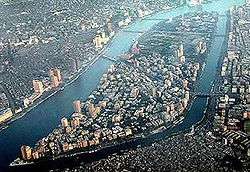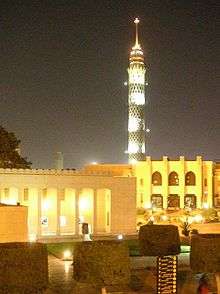Zamalek
 Aerial view looking south, with the Zamalek and Gezira districts on Gezira Island, surrounded by the Nile. |
A boat on the Nile in the Zamalek area. |
Zamalek (Egyptian Arabic: الزمالك pronounced [ez.zæˈmæːlek] which is originally derived from Turkish: üzümlük, meaning vineyard) is an affluent district of western Cairo encompassing the northern portion of Gezira Island in the Nile River. The island is connected with the river banks through three bridges each on the east and west sides of the island, including the Qasr El Nil Bridge and 6th October Bridge. It has witnessed many phases of growth affected by many economic and political currents which has led to a crowding of parts of the island including great reductions in the Zamalek district's open green areas, but with a large greenbelt across the island's middle defining the two districts.
Description

Zamalek, along with Maadi, Mohandessin, Heliopolis, and Garden City, is one of the affluent residential districts in Greater Cairo.[1] Many non-Egyptians live in Zamalek. There are many apartments with sporadic maintenance because the landlords rarely make improvements; there are rent control programmes that allow several Zamalek complexes to house low income and middle income Egyptians.[2]
The quiet, leafy streets and 19th-century apartment blocks and villas make this one of the most attractive parts of the city and a favored residential location for many of Cairo's European expatriates.[3] It is also the district of many fine restaurants, bars and cafes, including traditional open-air ahwas and European cappuccino bars. The Gezira Island area is culturally active: with art galleries and museums, including the Museum of Islamic Ceramics; and two of Cairo’s major music and performing arts venues — the spacious Egyptian Opera House complex, and the El Sawy Culturewheel Centre.
Several Zamalek buildings have an Art Deco style.[2]
History
Under Khedive Ismail the Island was called "Jardin des Plantes" (Garden of Plants), because of its great collection of exotic plants shipped from all over the world. French landscape designer De la Chevalerie designed the island's landscape plan, gardens, and plant nurseries. On the east shore a kiosk was built for attending the island and supervising its development.
The kiosk was replaced in 1869 with the Gezirah Palace, a U-shaped summer mansion, which was designed by Julius Franz Pasha and decorated by Karl Von Diebitsch. The palace was built and first used for guests attending the 1869 opening of the Suez Canal.[1] Emperor Franz Josef I of Austria and Eugénie, Empress of the French were some of the noble guests of the palace. Today the Gezira Palace is the central part of the Cairo Marriott Hotel, with its rooftop having an open-air theatre facing the Nile.
Other palaces were also built in Zamalek, including Prince Sa'id Toussoun's palace, which is now a branch of the Council of Ministers, and Prince Amr Ibrahim's palace (1924), which is now the Museum of Islamic Ceramics.[4][5] In 1882 the Gezira Sporting Club was built in the southern region of the island.[6] Later a water garden known as the "Grotto Garden," with a rare collection of African fish, was built by British Captain Stanley Flower in Zamalek.
Several notable Egyptian figures lived in Zamalek including the Diva of the East Umm Kulthum.
Demographics
As of 2010, over 420,000 people live on the island.
Landmarks

- Gezira Sporting Club (1882), the oldest club in Egypt.[6]
- Cairo Tower (1960), the tallest concrete construction in Egypt, built near the Gezira Sporting Club.[7]
- Egyptian Opera House (1988), built near the Cairo Tower, and one of the better performing arts venues in the Middle East.[8]
- El Sawy Culture Wheel Centre (2003), (Arabic: ساقية الصاوى) located beneath 15 May Bridge in Zamalek, one of the most important cultural venues in Egypt.[9]
- Museum of Islamic Ceramics [10]
- Faculty of Fine Arts [1908]
- Safir Hotel
- All Saints' Cathedral, Cairo
Education
International schools:
- Lycée Français du Caire Zamalek Primary Campus[11]
- Pakistan International School of Cairo
See also
| Wikimedia Commons has media related to El Zamalek. |
References
- 1 2 "Zamalek Today". e-dar.com. Retrieved 15 June 2010.
- 1 2 Hessler, Peter. "Tales of the Trash" (Archived 4 August 2015 at WebCite). The New Yorker. 13 October 2014. Retrieved on 4 August 2015.
- ↑ Zamalek | Areas in Cairo | Worldwide City Guide | Wanted Worldwide
- ↑ Dunn, Jimmy. "Zamalek". touregypt.net. Retrieved 8 August 2008.
- ↑ touregypt.net -image: Prince Amr Ibrahim palace-Museum of Islamic Ceramics
- 1 2 Raafat, Samir (17 February 1996). "Gezira Sporting Club milestones". egy.com. Archived from the original on 15 June 2008. Retrieved 8 August 2008.
- ↑ Raafat, Samir (16 August 1997). "The Cairo Tower". egy.com. Archived from the original on 15 June 2008. Retrieved 8 August 2008.
- ↑ "Egypt hosts London's Royal Philharmonic Orchestra". travelvideo.tv. 1 February 2007. Archived from the original on 31 December 2007. Retrieved 8 August 2008.
- ↑ "El Sawy Culturewheel in Egypt: From a place for beggars to a resort for intellectuals" (in Arabic). CNN. 2009-03-17. Retrieved 2009-04-01.
- ↑ The Museums of Islamic Art and Islamic Ceramics | Egyptian Monuments
- ↑ "L'administration du lycée." Lycée Français du Caire. Retrieved on 23 January 2015. "Zamalek Site primaire 8, rue Ibn Zanki"
Coordinates: 30°04′N 31°13′E / 30.067°N 31.217°E